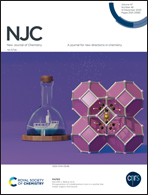An MIL-88A(Fe) rod-like metal–organic framework decorated with tungstophosphate polyoxoanions and nickel ferrite nanoparticles for the removal of antibiotics from water†
Abstract
In this work, a magnetic H3PW12O40(POT)/NiFe2O4/MIL-88A(Fe) nanocomposite was fabricated by the hydrothermal method and utilized as a stable and effective ternary adsorbent for the removal of ciprofloxacin (CIP) and tetracycline (TC) from aqueous solution. Characterization of the magnetic nanocomposite was performed by Fourier transform infrared (FT-IR) spectroscopy, X-ray powder diffraction (XRD), field emission scanning electron microscopy (SEM), energy dispersive X-ray spectroscopy (EDX), transmission electron microscopy (TEM), vibrating-sample magnetometer (VSM) measurement, Brunauer–Emmett–Teller (BET) specific surface area measurement, Raman spectroscopy and zeta potential analysis. Factors influencing the adsorption capacity of POT/NiFe2O4/MIL-88A(Fe) including primary dye concentration, pH, temperature, and adsorbent dose were analyzed. The maximum adsorption capacities of POT/NiFe2O4/MIL-88A(Fe) for TC and CIP were 200.93 mg g−1 and 181.12 mg g−1 at 25 °C, respectively. Moreover, the POT/NiFe2O4/MIL-88A(Fe) adsorbent had good regeneration capacity and reusability after three cycles of use. The adsorption process fit well with the Freundlich isotherm model and pseudo-second-order adsorption kinetics model, demonstrating a multilayer adsorption and chemical adsorption behavior. The adsorption mechanism was mainly ascribed to the electrostatic attraction and π–π interactions. According to these results, POT/NiFe2O4/MIL-88A(Fe) can act as an effective reusable adsorbent for the fast elimination of TC and CIP antibiotic drugs from aqueous solution.



 Please wait while we load your content...
Please wait while we load your content...